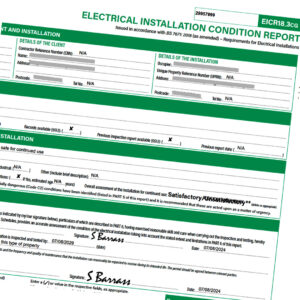What is an EICR?
 EICR stands for Electrical Installation Condition Report. It’s a formal document that assesses the safety and condition of an electrical installation. The EICR is carried out by a qualified and competent electrician and involves a series of tests and inspections to ensure that the electrical installation complies with the current regulations and is safe for continued use.
EICR stands for Electrical Installation Condition Report. It’s a formal document that assesses the safety and condition of an electrical installation. The EICR is carried out by a qualified and competent electrician and involves a series of tests and inspections to ensure that the electrical installation complies with the current regulations and is safe for continued use.
The purpose of an EICR is to identify any faults (in circuits or main earthing), non-compliances, wear and tear, or areas that may need maintenance or upgrading to meet the required safety standards.
Who Needs an EICR?
- Homebuyers (not mandatory, but strongly recommended) – you definitely don’t want to discover cable faults after you’ve nicely decorated and got new carpets or flooring down!
- Landlord Electrical Safety Certificate (mandatory for private landlords every 5 years) and must provide the EICR to the tenants (along with the gas certificate)
- Periodic (not mandatory) for homeowners (every 10 years), commercial businesses (every 5 years) or whenever required for technical or insurance requirements.
The report includes:
- A summary of the installation’s condition
- Details of any defects or potential dangers
- Recommendations for repairs or improvements, if necessary
The EICR is important for safety and legal compliance, especially for landlords, businesses, and property owners, ensuring the electrical system is fit for purpose and not a hazard.
Electrical Problems? Get Professional, Unbiased Advice Today
Contact an electrical consultant
EICR Testing Procedure
Note that the initial (technical) testing requires full power off for up to an hour, and that includes loss of WiFi for that period. However, many clients can switch to cell-mode for booked online meetings while laptops run on battery for that period.
Fridges and freezers as not at risk during this time.
✅ Visual inspection of all electrical end points such as sockets, switches, fixed lighting and consumer unit (or older style fuse box) for damage or non-conformity
✅ (Technical) test of main electrical earth integrity, together with verification of water and gas pipe earth bonding
✅ Test every circuit for existing cable damage
✅ Test continuity of socket ring circuits
✅ Test RCDs (if present)
✅ Test earthing values at sample sockets, lighting outlets and all fixed appliances
✅ Certificate indicating a ‘satisfactory’ or ‘unsatisfactory’ status (if the latter, we will quote for any required remedial work required)
Q: Why does an electrical test cost far more than a gas certificate?
A: It takes a lot longer to do as there’s a lot more to check!
Q: Does an EICR test every socket?
A: No. For ring circuits (i.e. upstairs or downstairs sockets) I’d pick on one per room. For lighting circuits, I pick on the final one on the loop.
What Happens if the EICR Test Fails
There are a number of reasons an EICR test may fail (actually denoted as ‘unsatisfactory’).
These are four categories denoted on the EICR
C1 = indicates a dangerous situation where life could be at risk from electrocution
(such as bare live wires, or mis-wiring that induces full mains potential onto the earthing system)
C2 = a potentially dangerous situation that requires remedy
(such as non functioning earthing, faulty/damaged cables on non RCD protected circuits or bare bulbs in a bathroom area)
C3 = Recommended actions that would improve a non-dangerous situation/s
(such as upgrading to RCD protection, changing halogen bulbs to LED to reduce fire-risk)
F/I = Something that can’t be clarified and would need to be investigated at extra cost.
There are dozens of reasons an EICR could return an ‘unsatisfactory’ result and while some outcomes are down to ‘interpretation’, an experienced electrician would come to pragmatic and fair conclusions and offer the client an affordable quote leading to a certificate with a ‘satisfactory’ outcome.
But beware the ‘electrician’ who fails a test and offers an outrageous price to fix things that don’t need fixing – it’s sadly all to common. Or the ‘electrician’ who fails a test with a long list of ‘repairs’ then vanishes without a trace – again, it’s very common.
EICR Testing Frequency/ EICR Testing Intervals
10 yearly – for properties where the owner permanently lives there
5 yearly – for all privately owned rental properties
5 yearly – HMO properties
Book your EICR
S.W. London, Surrey, Middlesex, and surrounding areas
FROM £195+vat


njnmnnn